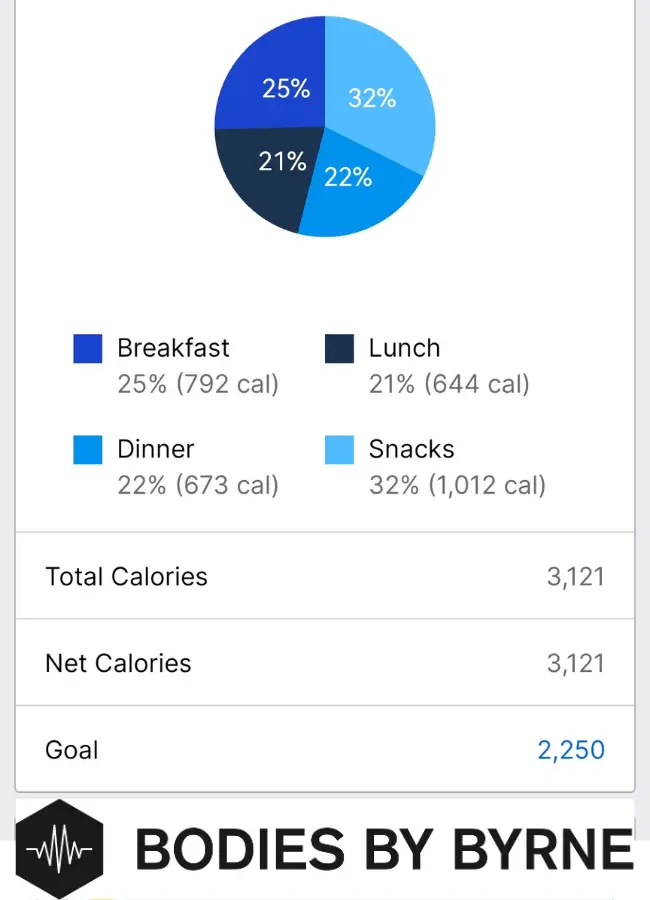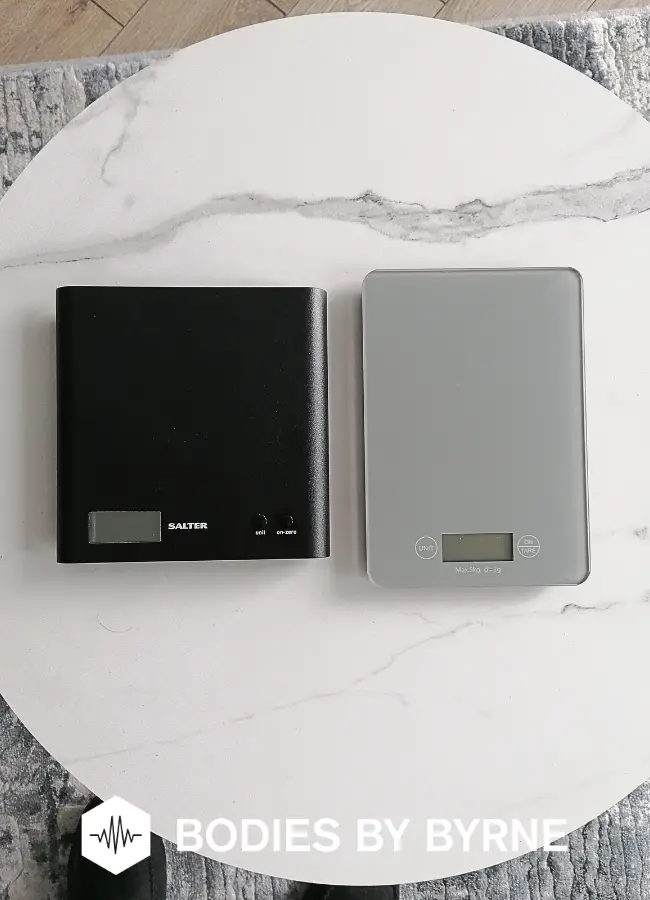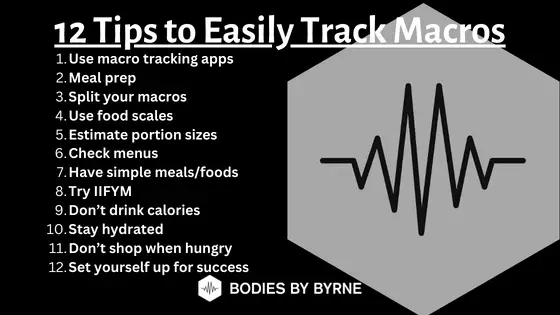Tracking macros, short for macronutrients (carbohydrates, proteins, and fats), has gained popularity in recent years as a flexible and effective way to manage nutrition.
Whether your goal is weight management, muscle gain, or simply maintaining a balanced diet, tracking macros can provide you with valuable insights into your dietary habits.
However, tracking macros can be complex and difficult, especially when starting out as a beginner.
To make tracking macros easier, there are a range of tips to try.
These include using macro-tracking apps, meal prepping, and evenly splitting your macros throughout the day, as well as many others.
From reading this article, you’ll learn:
– 12 simple tips for easily tracking macros
– Common challenges people experience when tracking macros
– How to overcome them
Tips for Tracking Macros
My top 12 tips for easily tracking macros are:
- Use macro-tracking apps
- Meal prep
- Evenly split your macros
- Invest in good scales
- Learn how to estimate
- Check menus
- Keep it simple
- Consider flexible dieting
- Avoid drinking calories
- Keep hydrated
- Don’t shop when hungry
- Set up for success
In the next section, I’ve expanded on each of these to explain how to get the most out of each of these tips.
1. Use Macro-Tracking Apps

There are numerous smartphone apps designed specifically for tracking macros, such as MyFitnessPal, Cronometer, and Lose It!.
These apps make it easy to input your meals, scan barcodes, and calculate macros.
Doing this throughout the course of the day means that you have a log of your intake. It also means that you don’t have to try and remember everything you’ve eaten throughout the day to input it in the evening.
Sure, you can track macros without an app but this is incredibly time consuming. I’ve done this before we had macro tracking apps and I had to add all the food I was eating onto a paper notepad.
This had a list at the back to show the food item, calories, and macro breakdown.
Now I use MyFitnessPal, scan a barcode and it does all the calculations for me.
It also saves your food items so everyday it takes me around 2 minutes to add all my meals (3 minutes if I’m having a new food item) and makes it so much easier to track macros on a daily basis.
Using an app just makes macro-tracking much more convenient and makes it more likely that you’ll find success with tracking macros.
2. Meal Prep
Another way to make tracking macro easier is by meal prepping.
Preparing meals in advance allows you to control the ingredients and portion sizes, making it easier to know how many calories your food contains, as well as the macros content.
Meal prepping also means that you have meals on hand to eat. This is great if you struggle to find time for cooking each day, or if you find yourself struggling with your diet when hungry.
To meal prep, consider batch-cooking for the week and portioning meals into containers. Simply heat these up when you’re ready to eat.
3. Evenly Split Your Macros

It can be overwhelming to look at the total amount of calories and macros for a day and think about how you will divide it.
An easy solution is to simply split your macros evenly for the three meals you plan to have during the day, minus any snacks.
Splitting your macros evenly meals you can then simply calculate the macros for each meal, making it less overwhelming.
Having an even amount of macros can also help to reduce feelings of hunger.
See also – Reduce hunger when cutting
Sometimes, people have a large share of their macros during breakfast and lunch, and then find themselves eating small portions, or unsatisfying meals, of an evening.
Splitting your macros evenly throughout the day can help to ensure you stay full over the course of the whole day, helping you to stick with your diet.
4. Invest in Good Scales

To be successful and reach your goals when tracking macros, precision is important.
Knowing exactly how much ingredients weigh will tell you their calorie content and macros split. Being imprecise can lead to inaccurate calculations that undermine your results.
For this reason, investing in good, reliable scales is key. Consistently measuring ingredients and portion sizes will support achieving long term results.
Good scales don’t need to be expensive. There are a range of affordable options available, including digital or analog versions.
I have two scales (one I usually keep in the work office) and they are inexpensive but just make it easy to weigh out food and be accurate on my calories and macros.
I’ve had a Salter scale for maybe 8 years now and it’s still going strong and you can still get the same model on Amazon.
You don’t need to be super strict weighing everything but even when not dieting, I’ll still weigh tricky foods like oats and rice where it’s almost impossible to eye-ball the right amounts.
Related – Tracking macros without a scale
5. Learn to Estimate
Following on from my last point above, whilst accuracy is important when it comes to tracking macros, you may not always be able to measure ingredients or portion sizes.
When you can’t accurately determine the macros split of food, estimating is key for reporting your daily intake. Learning to estimate is therefore a valuable tool for easily counting macros.
Different approaches can be used. For example, the “hand method” involves estimating the portion size of different food items using the palm of your hand.
Although, it should be mentioned that this method only provides an estimate and where possible you should try to use scales to be precise.
This video shows how best to utilize the hand method for measuring.
6. Check Menus
A major problem people face when tracking macros is how to track them when eating out. Unfortunately, restaurants may not provide the macros split of many dishes on their menu.
For this reason, it’s key to plan ahead and check menus in advance.
Many restaurants list the calorie content within meals, as well as the ingredients. From this, you can work out the macros split of meals and make an informed decision about what you want to order.
Also some sneaky tricks you can use is to use Ubereats or Deliveroo to see what the calories and macros are for some meals as restaurants may need to legally show this info on these apps.
You can also Google Search the restaurant and food to see what comes up. Some people may have already done the calculations for you.
If I want a cheat meal which is often pizza, someone has already put in the macro breakdown for a medium pizza on MyFitnessPal!
7. Keep it Simple
Learning how to track macros might pose an initial challenge, as it involves a learning curve, especially in the early stages.
However, at times, people tend to make the process more complex than necessary, which can result in them feeling overwhelmed and frustrated.
These emotions can eventually cause people to abandon their diets.
To simplify the process, it’s best to begin tracking macros by using a straightforward approach. For instance, start by monitoring macros in whole foods rather than meticulously scrutinizing every individual ingredient.
As you gain experience and become comfortable with the process, you can gradually expand your scope to include a wider variety of foods.
Additionally, consider exploring available resources on macro tracking.
There is a wealth of guidance and tools, such as online macro calculators, that can prove highly beneficial when starting on your macro tracking journey.
8. Be Flexible
Another alternative is to follow a flexible dieting approach, also known as “If It Fits Your Macros” (IIFYM). This approach involves tracking macronutrient intake, such as carbohydrates, protein, and fat, rather than following strict food restrictions.
This approach allows for more flexibility in food choices, as long as overall macronutrient intake is within the set split.
This approach may be more suitable for people who are finding it difficult to plan meals in advance, or stick to set diets.
9. Avoid Drinking Calories
Another tip for easily tracking macros is to avoid drinking calories.
While it might seem harmless, drinks like sodas, sugary coffee drinks, and fruit juices can significantly disrupt your macro-counting efforts.
This is because many drinks, especially sugary ones, are packed full of hidden calories.
A seemingly innocent frappuccino or soda can contain a substantial amount of sugar and carbohydrates, which can throw off your daily macro goals without providing the same satiety as solid food.
Also, liquid calories don’t tend to make you feel as full as solid foods do.
When you consume empty calories in the form of drinks, you might still be tempted to eat more food later, potentially exceeding your daily macros.
It’s also easy to underestimate the number of calories in a drink, especially when dining out.
Restaurants often serve oversized portions, and even seemingly healthy smoothies can contain excessive sugars and fats.
For this reason, it’s best to avoid sugary drinks when tracking macros. If you do have a sugary drink, make sure to account for it in your macros split.
10. Stay Hydrated
Whilst you shouldn’t drink your calories when tracking macros, this doesn’t mean hydration isn’t important.
Adequate hydration is essential for maintaining optimal metabolic function.
When you’re dehydrated, your body’s ability to process and utilize nutrients, including macros, can be impaired. This can lead to a sluggish metabolism, making it harder to achieve your dieting goals.
Also, thirst is sometimes confused with hunger, leading to unnecessary calorie consumption.
By staying well-hydrated, you can better differentiate between true hunger and thirst, helping you avoid overeating and stay on track with your macro targets.
If you’re incorporating exercise into your diet plan, staying hydrated is even more critical.
Dehydration can lead to muscle cramps, reduced endurance, and impaired workout performance. By drinking enough water, you’ll be better equipped to maximize your training efforts.
To stay hydrated, make sure you’re drinking enough water throughout the day to support your activities.
11. Don’t Shop When Hungry
Avoiding shopping when hungry is important when it comes to tracking macros.
When you’re hungry, you’re more likely to succumb to cravings and make impulsive food choices.
These spur-of-the-moment decisions can lead to the purchase of high-calorie, low-nutrient foods that don’t align with your macro goals.
Hunger-driven shopping often results in a cart filled with items that don’t fit your macro targets.
You may be tempted to buy more carbohydrates or unhealthy snacks, throwing off your carefully calculated diet plan.
When you shop while hungry, your focus tends to shift toward satisfying immediate cravings rather than making mindful, nutritious choices.
You’re less likely to prioritize the purchase of lean proteins, fresh produce, and other macro-friendly foods.
Impulsive shopping can also have financial implications.
Purchasing items you didn’t plan for can strain your budget, potentially limiting your ability to invest in high-quality, macro-compliant foods.
To ensure you’re buying the right things that support your macro tracking goals, allocate time to shop when it’s convenient so you don’t end up shopping hungry.
Also, plan your shopping list in advance so that you know what foods you should buy. This eliminates any decision fatigue and means you can go into the store on a mission, focused, and not distracted by any “special buy” aisles.
12. Set Up for Success
Another key tip for easily tracking macros is to set yourself up for success.
For example, a successful dieting environment minimizes temptations by removing or limiting access to high-calorie, low-nutrient foods.
When you’re surrounded by macro-friendly options, it’s easier to make healthier choices.
One simple thing to do is not buy your cheat foods. If you know you can resist a midday soda, do not have any in your home.
By eliminating any typical failure points, you immediately increase your chance of a successful dieting phase.
You could also make tracking macros more convenient by prepping and storing macro-compliant meals and snacks.
This reduces the temptation to grab unhealthy alternatives when you’re in a hurry or feeling hungry.
Setting yourself up for success also involves being accountable.
Inform friends and family about your dieting goals so they can support your efforts. Social support can help keep you on track and encourage adherence to your macro targets.
Common Macro Tracking Challenges & How to Overcome Them
While tracking macros offers many benefits, it can also present challenges. Here are some common hurdles and strategies to overcome them:
1. Inconsistent Tracking
Some people struggle to track consistently and will only track on certain days, or for certain meals.
Solution: Make tracking a habit through setting aside a specific time each day to log your meals, as well as any snacks you’ve had.
2. Social Events and Eating Out
Many people avoid social events when dieting, for fear that the meals they’re eating won’t fit into their diet.
However, this can lead to feelings of resentment and may lead people to abandon their diets.
Solution: Plan ahead when attending social events. Look up restaurant menus in advance and make healthier choices when possible.
3. Lack of Variety
It’s easy to fall into a habit and stick to the same meals you know fit in your macros. However, eating the same foods again and again gets boring.
Solution: Experiment with a variety of foods to avoid dietary boredom and ensure you meet your micro and macro needs.
4. Traveling
People can struggle to continue with tracking macros when they’re traveling.
Solution: Bring portable snacks and research local cuisine options in advance to stay on track while traveling.
5. Plateaus in Progress
People can experience plateaus in progress when tracking macros. This can be disheartening and may negatively affect motivation levels.
Solution: Periodically reassess your macros and adjust them if you hit a plateau in your progress.
6. Lack of Time
Tracking macros can feel time-consuming and people may be discouraged if they feel they don’t have time to track.
Solution: Pre-plan meals and use quick, nutritious recipes to simplify tracking on busy days.
Overall

Tracking macros is a powerful tool for optimizing your nutrition and achieving your health and fitness goals.
Whether you’re aiming to lose weight, build muscle, or simply eat more mindfully, the tips and easy methods discussed in this guide can help you track macros effectively.
If you still need a bit more info before you start to track macros then check out our more in depth guides which include a step by step guide on counting macros and also what happens if you go over your macros.